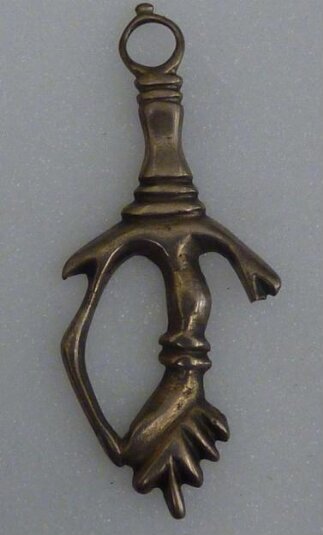Cimaruta: Magical Rue
“Highly regarded since ancient times, rue was recognized as medically helpful for more than 80 complaints by the time of the early Roman Empire. The first century A.D. scholar Pliny reported that it preserved eyesight and noted that painters and engravers ate a good deal of rue. In the 16th and 17th centuries, it was advocated as an antidote for all sorts of poisons, from toadstools to serpent bites. Because of rue’s strong, rather musty odor, it enjoyed particular prominence for warding off pestilences. At one time in Catholic churches, brushes made of rue were used to sprinkle Holy Water before Mass — a practice that may explain another of the plant’s common names, herb-of-grace.” — Magic and Medicine of Plants
***
Rue (Ruta graveolens) is a perennial shrub that is native to the Mediterranean region and has long been used as a culinary and medicinal plant. The name of the herb rue comes from the Latin word ruta, which is derived from the Greek word rua, meaning “to set free” because rue was believed to set people free from disease or poisoning.
The plant has distinctive looking, bluish-green spoon shaped leaves and yellow flowers. It has a strong and unusual aroma that The House would describe as both musty and musky. When used culinarily, it imparts a slightly bitter and earthy taste. But rue is highly toxic to both the internal organs and skin and should be ingested and used sparingly.
Rue has a long history of use in both medicine and magic, and is considered a protective herb in both disciplines. The plant has antispasmodic, antifungal and antimicrobial properties and was also prescribed to stimulate menstruation and induce abortion. Because rue was believed to have the power to ward off evil and protect from curses, the leaves were sometimes dried and burned, brewed in a tea, or used to make amulets.
Rue is strongly associated with feminine energy. The plant was associated with Diana, goddess of the hunt and patron of the moon, but also with the Virgin Mary. Rue was said to be the only plant that grew on Mount Calvary, where Jesus was crucified. The legend is that a rue plant at the foot of the cross was watered by Mary’s tears and rue therefore became a symbol of her sorrow and grace (hence its alias, “herb o’grace”). But rue is also associated with suffering and salvation because it was said to be the herb that Roman soldiers used to make a crown of thorns for Jesus and the herb that was mixed with vinegar and offered to him on a sponge.
In Italian folk magic, rue has been used by “witches” (streghe) for protection or to block the evil eye (malocchio), which is why rue is sometimes referred to as “witchbane.”
The cimaruta (literally, “sprig of rue”) is typically worn as a necklace or hung above an infant's bed as a protective amulet. The amulet is usually made of silver metal and depicts a stylized stalk of rue consisting of three main branches with different “charms” at the end of each branch. Common charms include: key, moon, heart, bird, fish, serpent, flower, helmet, cherub, eagle, dagger, etc. Each charm has a distinct symbolic meaning, and all are associated with the goddess Diana.
The Science Museum Group has a wonderful collection of cimaruta amulets, many of which are quite old. Some are more elaborate and adorned than others, and it’s interesting to see which symbols are used on a particular amulet as you compare the older pieces to the more modern iterations.
Additional Reading: For those who are interested in exploring a theory that the cimaruta is actually a composite charm, please read this article that appeared on a now-defunct website called Stregheria.com. It’s accompanied by great illustrations.









